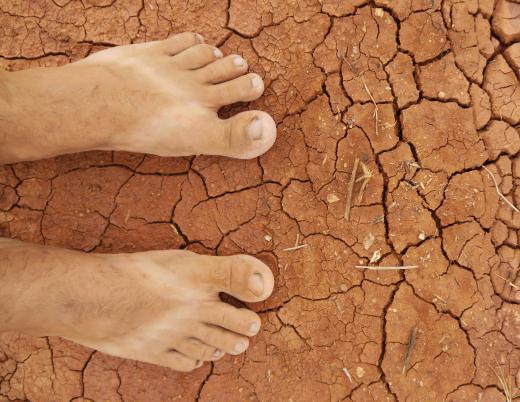What is the Groundwater Table?
The groundwater table, usually called the water table, is the depth at which the ground becomes saturated, or filled to maximum capacity, with water. When water reaches the surface of the Earth, either through rain, flooding, or some other means, the water begins to infiltrate, or pass into, the ground. The subsurface water trickles downward through pores in rocks and soil until it reaches a point where all available spaces are full. Though the term is often used loosely, groundwater technically refers only to water at or below this level. In this way, the groundwater table can be thought of as the top surface of groundwater.
The ground can be divided into two parts: the unsaturated zone that lies above the groundwater table and the saturated zone that lies below the water table. The subsurface water that travels through the top six to ten feet (1.83-3.05 meters) of the ground nourishes the roots of plants and is called soil water. As the subsurface water travels downward past the roots in the unsaturated zone, it becomes known as vadose water. Vadose water makes its way down to the saturated zone through pores, or small holes, in rock and sediment until it reaches the water table and becomes groundwater.

The depth at which the groundwater table occurs can vary greatly, from a few feet in some places, to hundreds or thousands of feet in other places. This variance can depend on several factors including regional topography, or the surface features of the Earth in a particular area, the type of material water has to pass through, seasons, and water extraction. Water tables are often shallower underneath valleys and deeper under hills, because there is a longer distance to travel. The rate at which the ground becomes saturated, and thus the rate at which the groundwater rises, also depends on the porosity, or the amount of space, in the ground’s material. Rock, for example, fills up faster than sand because there is simply less free space to fill.

Seasonal droughts, flooding, or precipitation can also affect the level of the water table if it is not too far from the ground surface. Some saturated zones are located so deeply, however, that the length of time it takes water to infiltrate to the saturated zone evens out seasonal changes, leaving the groundwater table unaffected by seasonal variance. In general, infiltration is a slow process, as is the process of discharge, in which water naturally leaves the aquifer.
An aquifer is an area of rock or sediment that contains groundwater which can be accessed for use by humans. One such example is the Ogallala aquifer which spans roughly 174,000 square miles (450657.9 square kilometers) in the American Midwest. Unlike a confined aquifer, in which the groundwater is trapped between impermeable material, the Ogallala is unconfined and can still be recharged by snowmelt, rainfall, and other types of surface water.
Like many other aquifers, however, the rate of recharge in the Ogallala is very slow, and the rate of extraction is high. Humans extract, or take out, water from aquifers in high volumes for agriculture, residential use, and industry. When the rate of extraction outstrips the capacity of the aquifer to recharge, it is called overdraft and causes the groundwater table to drop. Overdraft has caused the groundwater table in many places on the Ogallala to drop over 100 feet, or more than 30.5 meters.
AS FEATURED ON:
AS FEATURED ON:












Discuss this Article
Post your comments